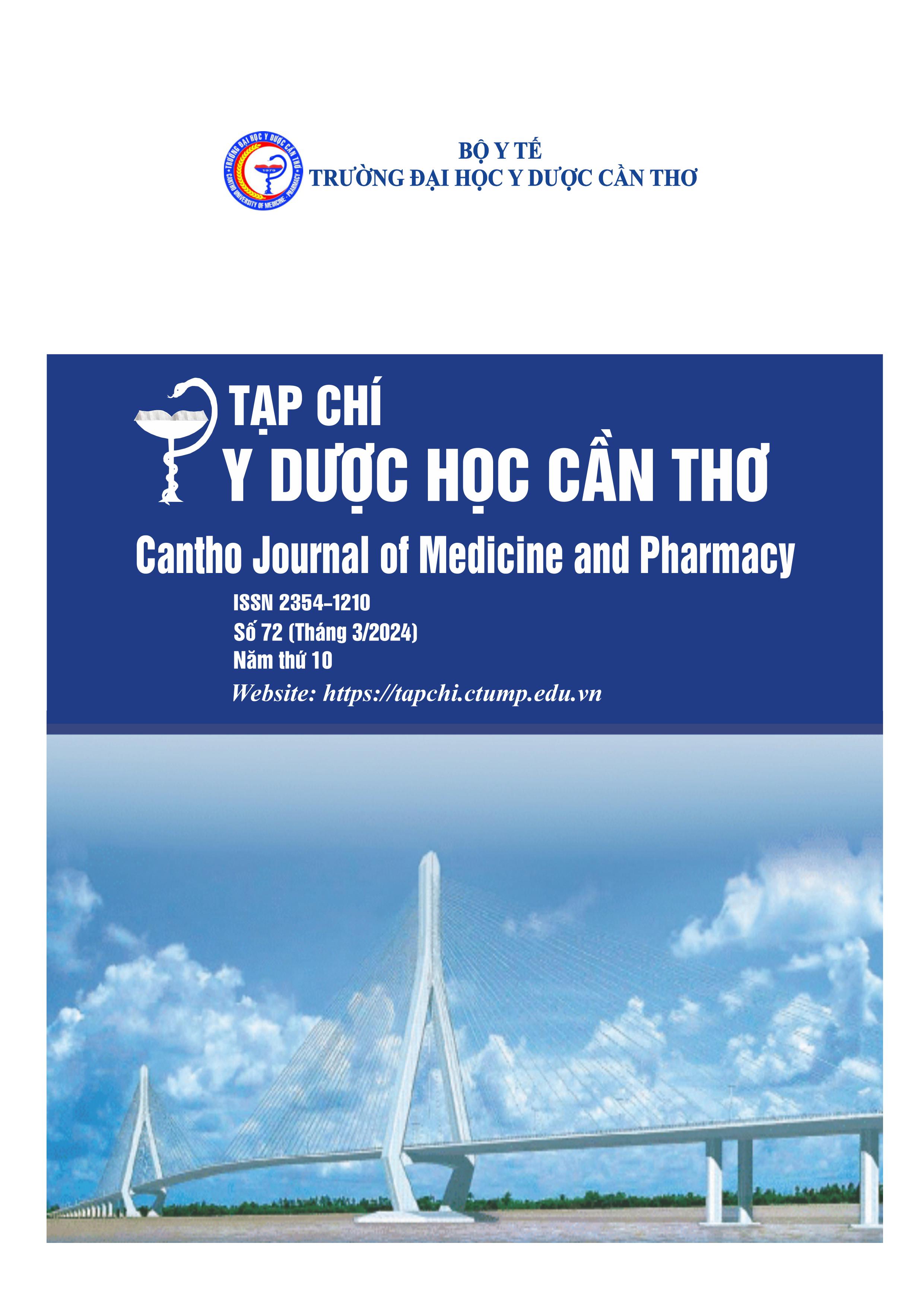PREVALENCE, CLINICAL AND PARACLINICAL CHARACTERISTICS OF INTESTINAL PARASITIC INFECTIONS IN INPATIENT AT THE DEPARTMENT OF GASTROENTEROLOGY–CLINICAL HEMATOLOGY OF CAN THO CENTRAL GENERAL HOSPITAL IN 2022-2023
Main Article Content
Abstract
Background: Intestinal parasitic infections are still common in our country and affect human health. Although the mortality rate from these infections is relatively low, complications are not. rare. Therefore, studying the situation of intestinal parasitic infections and their effects is necessary. Objectives: To determine the infection rate and describe clinical and paraclinical characteristics in inpatients at the Department of Gastroenterology - Clinical Hematology, Can Tho Central General Hospital. Materials and methods: Including 97 patients diagnosed with intestinal parasitic infection by direct stool examination, clinical and paraclinical characteristics, survey of risk factors for parasitic infection. Results: The rate of intestinal parasitic infections were 20.61%. In mono-infection cases, the rate of yeast is 7.21%, hookworm is 3.09%, Entamoeba histolytica was 2.06%, Strongyloides stercoralis was 1.03%, Blastocystis hominis was 1.03%. %, Entamoeba coli was 1.03%, Candida sp. was 1.03%. The infection rate of Entamoeba histolytica and yeast was 1.03%, Blastocystis hominis and yeast was 3.09%. Patients had clinical abdominal pain (75%), diarrhea (80%), and subclinical eosinophil elevation (75%). Conclusion: Intestinal parasitic infections are mainly caused by Yeast, Blastocystis hominis, and Ancylostoma duodenale. Common clinical conditions are abdominal pain and diarrhea. Increased eosinophil is a sign of intestinal parasitic infection.
Article Details
Keywords
Parasites, Intestinal parasitic infections, Entamoeba coli
References
2. Ashok Moloo. Schistosomiasis and soil-transmitted helminthiases: treating millions of people, despite the pandemic. Weekly epidemiological record. 2021. https://www.who.int/news/item/08-12-2021-schistosomiasis-and-soil-transmittedhelminthiases-treating-millions-of-people-despite-the-pandemic.
3. Phạm Hoàng Minh Quân. Nghiên cứu tình hình nhiễm ký sinh trùng đường ruột tại Khoa Nội Tiêu hóa và Huyết học lâm sàng BVĐKTW Cần Thơ năm 2014 – 2015. Trường Đại học Y Dược Cần Thơ. 2015. 72.
4. Sơn Thị Tiến, Phan Hoàng Đạt, Lý Quốc Trung, Nguyễn Tấn Đạt. Nghiên cứu tình hình nhiễm ký sinh trùng và một số yếu tố liên quan trên bệnh nhân đến khám và điều trị tại bệnh viện trường Đại học Y Dược Cần Thơ năm 2022. Tạp chí Y Dược Cần Thơ. 2022. 55, 207-213, https://doi.org/10.58490/ctump.2022i55.408.
5. Buonsenso, Danilo MD. Intestinal Parasitic Infections in Internationally Adopted Children: A 10-Year Retrospective Study. The Pediatric Infectious Disease Journal. 2019. 38(10), 983-989, DOI: 10.1097/INF.0000000000002399.
6. Lê Đình Vĩnh Phúc. Nghiên cứu đặc điểm lâm sàng, cận lâm sàng và kết quả điều trị bằng thiabendazole trên người mắc bệnh ấu trùng giun đũa chó, mèo tại trung tâm Medic thành phố Hồ Chí Minh. Luận án tiến sĩ. Viện sốt rét – Ký sinh trùng – Côn trùng Trung ương. 2021.
7. M.L.F.N. Benetton, A.V. Gonçalves. Risk factors for infection by the Entamoeba histolytica/ Entamoeba dispar complex: An epidemiological study conducted in outpatient clinics in the city of Manaus, Amazon Region, Brazil. Transactions of the Royal Society of Tropical Medicine and Hygiene. 2020. 99(7), 532-540, https://doi.org/10.1016/j.trstmh.2004.11.015.
8. Ma Văn Thấm. Đặc điểm lâm sàng, cận lâm sàng bệnh lỵ amip do Entamoeba Histolytica khoa nhi tại bệnh viện đa khoa quốc tế Vinmec Phú Quốc. Tạp chí nhi khoa hội nhi khoa Việt Nam. 2023. 16 (2), 23-28, https://doi.org/10.52724/tcnk.v16i2.189.
9. James J. Yahaya, Emmanuel D. Morgan, Emmanuel Othieno. Duodenal Strongyloides stercoralis infection in a 56-year old male: A case report. International Journal of Surgery Open. 2023. 57, https://doi.org/10.1016/j.ijso.2023.100651.
10. Vũ Thị Thu Băng. Một số đặc điểm lâm sàng, cận lâm sàng ở bệnh nhân nhiễm ấu trùng giun đũa chó mèo Toxocara spp. đến khám tại bệnh viện Đặng Văn Ngữ năm 2021 – 2022. Tạp chí Phòng chống bệnh sốt rét và các bệnh ký sinh trùng. 2022. 2 (128), 27-34, https://doi.org/10.59253/tcpcsr.v128i2.9.
11. Đinh Xuân Tuấn Anh, Tôn Nữ Phương Anh. Nghiên cứu tỉ lệ nhiễm ký sinh trùng đường ruột, sự thay đổi công thức máu trước và sau khi điều trị, các yếu tố liên quan của bệnh nhân đến khám tại Bệnh viện trường Đại học Y Dược Huế. Tạp chí Y Dược học – Trường Đại học Y Dược Huế. 2017. 7(4), 62-68, https://www.doi.org/10.34071/jmp.2017.4.8.
12. Nerea Castillo Fernández, Manuel J. Soriano Pérez, Ana Belén Lozano Serrano, María Pilar Luzón García, María Isabel Cabeza-Barrera et al. Misleading eosinophil counts in migration-associated malaria: Do not miss hidden helminthic co-infections. Travel Medicine and Infectious Disease. 2022. 49, https://doi.org/10.1016/j.tmaid.2022.102415.


